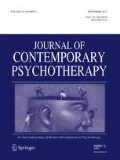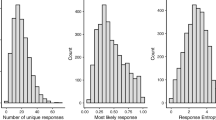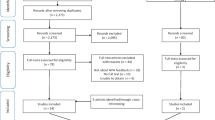Abstract
Often, sentence completion tests are administered to clients without a clear sense of the clinical questions to be investigated, and, therefore, the appropriate sentence completion instrument to be used. The multitude of forms that have evolved in the last fifty years have made it difficult for clinicians to make informed decisions about which form to use and for what purpose. This article presents ten general guidelines or considerations for the effective use of this popular but sometimes misused psychological assessment method. Practitioners are urged to consider such issues as oral versus written presentation of items, item content in terms of positive or negative stimulus pull, the structure of sentence stems, the original purpose of a given test in regard to intended population and theoretical orientation of the author, and the empirical validity of tests.
Similar content being viewed by others
References
Ames, P.C. & Riggio, R. E. (1995). Use of the Rotter Incomplete Sentences Blank with adolescent populations: Implications for determining maladjustment. Journal of Personality Assessment, 64(1), pp. 159–167.
Campbell, D.T.A. (1957). A typology of tests, projective and otherwise. Journal of Consulting Psychology, 21, 207–210.
Daston, P.G. (1968). Word associations and sentence completion techniques. In A.I. Rabin (Ed.), Projective techniques in personality assessment, 264–289. New York: Springer.
Forer, B.R. (1950). A structured sentence completion test. Journal of Projective Techniques, 14, 15–30.
Gibb, H. & Wales, R. (1990). Metaphor or simile: Psychological determinants of the differential use of each sentence form. Metaphor & Symbolic Activity, 5(4), 199–213.
Goldberg, P.A. (1965). A review of sentence completion methods in personality assessment. Journal of Projective Techniques & Personality Assessment, 29(1), 12–45.
Holaday, M., Smith, D.A., & Sherry, A. (2000). Sentence Completion Tests: A review of the literature and results of a survey of members of the Society of Personality Assessment. Journal of Personality Assessment, 74(3), 371–383.
Holsopple, J.Q. & Miale, F.R. (1954). Sentence completion; a projective method for the study of personality. Springfield, Ill.: Basic Books.
Lah, M.I. (1989a). Sentence completion tests. In Newmark, S.C., (Ed.), Major Psychological Instruments, Vol. II. Boston: Allyn and Bacon.
Lah, M.I. (1989b). New validity, normative, and scoring data for the Rotter Incomplete Sentences Blank. Journal of Personality Assessment, 53(3), 607–620.
Lane, R.C. (1948). The use of the sentence completion test as a projective technique with adolescents. Unpublished; completed as part of Doctoral degree requirements, Graduate School of Arts and Sciences, New York University.
Loevinger, J. (1998). History of the sentence completion test for ego development. In J. Loevinger (Ed.)Technical Foundations for Measuring Ego Development. London: Erlbaum.
Marziali, E., Field, N., Classen, C. & Oleniuk, J. (1993). The assessment of ego development in borderline personality disorders. Canadian Journal of Psychiatry, 38(1), 23–27.
Mayers, K.S. (1991). A sentence completion task for use in the assessment of psychotic patients. American Journal of Forensic Psychology, 9(2), 19–30.
Meltzoff, J. (1951). The effect of mental set and item structure upon response to a projective test. Journal of Abnormal and Social Psychology, 46, 177–189.
Rabin, A.I. (1968). Adapting and devising projective methods for special purposes. In A. I. Rabin (Ed.), Projective techniques in personality assessment. New York: Springer.
Rabin, A.I. & Zltogorski, Z. (1981). Completion Methods: Word Association, Sentence, and Story Completion. In A.I. Rabin, (Ed.)Assessment with Projective Techniques, A Concise Introduction, New York: Springer, 126–149.
Rabin, A.I. & Zltogorski, Z. (1985). The sentence completion method—recent research. Journal of Personality Assessment, 49(6), 641–647.
Rotter, J.B., & Rafferty, J.E. (1950). Manual for the Rotter Incomplete Sentences Blank: College form. New York: Psychological Corporation.
Sacks, J.M., & Levy, S. (1950). The sentence completion test. In L.E. Abt & L. Bellak (Eds.), Projective psychology: Clinical approaches to the total personality (pp. 357–402). New York: Knorf.
Silverstein, M.L. (1999). Self Psychology and Diagnostic Assessment. pp. 86–87. Weiner, I.B., ed. London: Lawerence Erlbaum Associates.
Stephens, M.W. (1970). Stimulus pull as a determinant of individual differences in sentence completion responses. Journal of Projective Techniques & Personality Assessment, 34(4), 332–339.
Wood, F.A. (1969). An investigation of methods of presenting incomplete sentence stimuli. Journal of Abnormal Psychology 74(1), 71–74.
Author information
Authors and Affiliations
Rights and permissions
About this article
Cite this article
Rogers, K.E., Bishop, J. & Lane, R.C. Considerations for the Use of Sentence Completion Tests. Journal of Contemporary Psychotherapy 33, 235–242 (2003). https://doi.org/10.1023/A:1023977704349
Issue Date:
DOI: https://doi.org/10.1023/A:1023977704349




